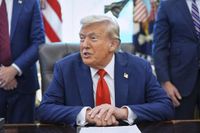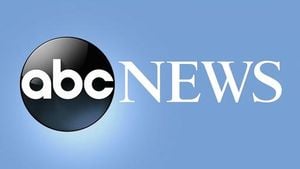In a spectacle that combined symbolism, politics, and controversy, President Donald Trump was presented with an honorary badge from the US Marshals Service and a symbolic handcuff key during a White House ceremony on August 26, 2025. The event, held in the Oval Office, was more than just a photo opportunity—it was a moment that encapsulated the administration’s law-and-order agenda and set the stage for a series of sweeping executive actions aimed at quelling unrest and crime in American cities.
The ceremony began with Attorney General Pam Bondi, beaming with enthusiasm, introducing US Marshals Service Director Gady Serralta. According to MEAWW, Bondi addressed the president with the excitement of someone unveiling a holiday gift, inviting Serralta to step forward. Serralta, in turn, expressed his appreciation for Trump’s support of federal law enforcement, stating, “Mr president, thank you for placing me in charge of this mission.” He continued, “On behalf of all the federal law enforcement agencies that we’re working with, and those that have yet to join the team, we thought it was only appropriate to present you with an honorary United States Marshals Service badge.”
The gesture didn’t end there. Serralta handed Trump a symbolic handcuff key, praising the president’s policies for “un-handcuffing law enforcement” and giving police “the tools they need.” Trump, visibly pleased, smiled for the cameras and called the presentation a “very great honor,” vowing to “save it and put it someplace important.” His childlike grin—noticeably without showing teeth—quickly became a talking point among reporters and online observers, some of whom noted the president’s visible excitement over the symbolic gifts.
Supporters were quick to celebrate the moment on social media. One user wrote, “Awesome! Law enforcement loves President Trump!” Another chimed in, “Marshals showing Trump some love, you love to see it.” Others saw the badge as a fitting tribute to the president’s law-and-order brand, with comments such as, “Wow, love it, our President of peace is now an honorary US Marshal, very fitting indeed,” and, “That was a great moment! Very meaningful gift. Well deserved!” The online reaction was overwhelmingly positive among Trump’s base, with many framing the badge as a symbolic nod to his tough-on-crime stance.
But the ceremony was just the opening act. According to the Associated Press, President Trump used the occasion to announce a new executive order mandating that the National Guard in each state create a quick-response force to quell protests and deter crime. The order, signed on August 25, 2025, tasks Defense Secretary Pete Hegseth with ensuring that each state’s Army National Guard and Air National Guard is “resourced, trained, organized and available to assist federal, state and local law enforcement in quelling civil disturbances and ensuring public safety and order whenever the circumstances necessitate, as appropriate under law.”
Trump didn’t mince words when discussing cities facing unrest. During a news conference, he said, “I think we should really let them have their city, let their city go to hell and then they will ask us for help.” He added, “These people [troops and federal law enforcement], eventually, they’re going to have to be appreciated for what they are doing, and they’re going to have to be appreciated by the officials that are really happy when we go in because they’ve lost control of their place.”
The executive order comes on the heels of a significant troop deployment in the nation’s capital. More than a week prior, Trump had sent 2,000 National Guard troops from Washington, D.C., and six supporting states to patrol the city, responding to what he called an emergency crime wave. Yet, D.C. police data told a different story: violent crime was actually down by 26% compared to the previous year, which had already marked the lowest levels in three decades. Trump, however, pointed to the absence of killings in the city since the deployment as evidence of its effectiveness.
The president’s willingness to use military force in American cities didn’t stop at Washington. He floated the idea of similar deployments to other major urban centers, specifically naming Chicago. “We may just go in and do it, which is probably what we should do,” Trump said. “The problem is, it’s not nice when you go in and do it, and somebody else is standing there saying, as we give great results, say, ‘Well, we don’t want the military.’”
Chicago, like D.C., had also experienced a decline in violent crime in 2025, according to police data. Illinois Governor JB Pritzker made his opposition clear, stating there was no emergency requiring National Guard or military intervention. “Donald Trump’s threat to bring the National Guard to Chicago isn’t about safety—it’s a test of the limits of his power and a trial run for a police state,” Pritzker said.
The debate over federal intervention in local law enforcement isn’t new. Two months prior, Trump had activated more than 4,000 members of the California National Guard and 700 Marines to deploy to Los Angeles during immigration protests that erupted after federal raids on businesses suspected of employing people living in the U.S. without authorization. The majority of those troops have since returned home, but their primary mission was to protect federal property and personnel, including agents conducting immigration arrests. Local officials in both Los Angeles and Washington, D.C., did not support the deployments, and California Governor Gavin Newsom filed a lawsuit arguing the move was illegal—a case still winding its way through federal court.
Legal experts have pointed to the Posse Comitatus Act of 1878, which bars military troops from conducting domestic law enforcement activities. However, the law has been tested in recent years, with troops used for crowd control during protests and emergencies. The Trump administration’s actions have reignited debate over the balance between federal authority and local autonomy, especially when it comes to policing and public safety.
As the ceremony concluded, the symbolic weight of the badge and handcuff key lingered. For Trump’s supporters, it was a moment of validation—a sign that the president stood firmly with law enforcement and was willing to take bold action to restore order. For critics, it was a troubling indication of a growing willingness to blur the lines between civilian governance and military intervention.
The events of August 25 and 26, 2025, will likely be remembered as a turning point in the ongoing debate over public safety, civil liberties, and the role of the federal government in American life. Whether viewed as a necessary response to unrest or a dangerous overreach, the symbolism of the badge—and the policies it represents—will continue to spark discussion and division across the country.




